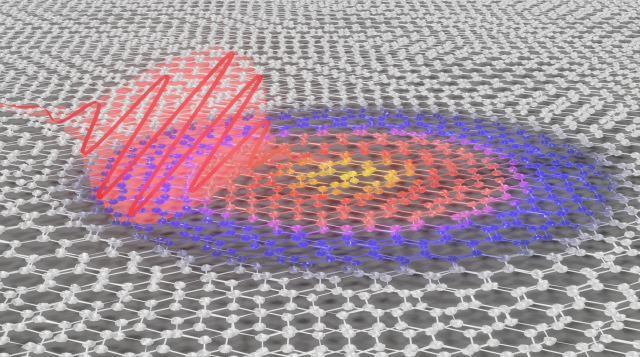19 September 2024
Detecting single photons with a ‘magic’ twist
An international team from LMU, Harvard University, and the Institute of Materials Science in Japan have successfully demonstrated the detection of individual photons in the infrared spectrum by utilizing a revolutionary material called magic-angle twisted bilayer graphene. This discovery represents a significant step towards extending superconducting single-photon detection to longer-wavelength photons.The results are featured today in Science Advances.
A single photon is an elementary excitation of the electromagnetic field. The concept of quantized electromagnetic radiation was first introduced by Max Planck in 1900 to explain the black-body radiation spectrum and then used by Albert Einstein in 1905 to explain the photoelectric effect. Today, highly sensitive devices known as single-photon detectors can generate a pulse signal upon the absorption of single photons and are essential components in quantum cryptography, astrophysical research, and advanced communication systems.
Single-photon detection is typically achieved using superconducting materials. In a superconductor, electricity can flow without resistance. When a photon impinges on a superconducting device, the deposited energy perturbs the superconducting state, inducing a measurable electrical signal. However, while single-photon detectors in the visible and near-infrared range are commercially available, extending these capabilities to the mid-infrared and terahertz regions remains a significant challenge due to the extremely low energy of these photons. Achieving this major goal requires novel detector concepts and the exploration of new material platforms beyond traditional superconducting materials.
The ‘magic’ of ‘magic’ angle
 © Efetov Group / LMU
© Efetov Group / LMU As Prof. Dmitri K. Efetov explains: “Our novel approach is relatively simple. If the number of electrons contributing to the superconducting state is exceptionally low, even a single low-energy photon can significantly disrupt the superconducting state, opening a new avenue to extend single-photon detection across a broader spectral range”.
Efetov’s research group, a member of the Cluster of Excellence MCQST, is one of the few worldwide that has mastered the fabrication of magic-angle superconducting samples. The devices are assembled vertically using two-dimensional van der Waals materials and require precise alignment of the two graphene layers at a small angle of 1.1°.
“Over the years, we were able to optimize the fabrication protocol and obtain ultra-high-quality superconducting devices essential for detecting single photons” explains Giorgio Di Battista, PhD student and first author of the paper in Science Advances.
Platform for the development of novel quantum devices and sensors
The researchers illuminated the 'magic-angle' device at extremely low temperatures, approximately tens of millikelvin (less than one degree above absolute zero), with a highly attenuated infrared laser source. By reducing the laser power to a regime where only isolated photons reached the detector and monitoring the induced electrical signal, they were able to confirm the detection of individual infrared photons.
The potential of this work is not limited to magic-angle graphene but extends to a broader family of graphene-based superconductors characterized by ultra-low electron densities. Prof. Efetov and his team's research opens up exciting possibilities for utilizing these materials as a novel platform for creating revolutionary quantum devices and sensors.
Publication
Infrared single-photon detection with superconducting magic-angle twisted bilayer graphene
G. Di Battista, K.C. Fong, A. Diez-Carlon, K. Watanabe, T. Taniguchi, D. K. Efetov
Science Advances, Vol 10, Issue 38 (2024)
DOI: 10.1126/sciadv.adp3725